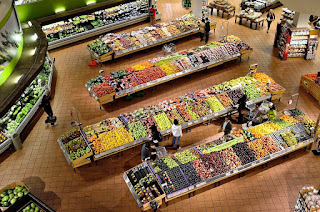 |
| Supermarket stalls |
To prepare healthy meals at home, you need the right ingredients. Here’s how to shop so that you have the best recipe materials in your pantry.
- Take an inventory of what you already have.
Make a list of not only the staples (low-fat milk, whole grains in breads and pasta, fresh fruits and vegetables) that you regularly run out of, but also of items on kitchen and pantry shelves. What canned goods do you already have that you could incorporate into upcoming meals? - Plan meals until your next shopping trip.
Using the inventory, find nutritious recipes that incorporate the items on the list. Make a plan for daily meals and snacks that include these products in healthy recipes. - Make a shopping list.
Using the menu plan you have developed, make a list of items to purchase. Try to organize your list so that items are arranged in the order you will encounter them as you move through the store. Shopping from a list makes the trip more efficient, and curbs impulse buying of unhealthy items.
You can always be on the lookout for healthy items that are not on your list. Give yourself the opportunity to try out a new fruit or vegetable. Often these make convenient healthy snacks. - Don't shop when you're hungry.
You are more likely to grab high-fat, high-calorie snack items when you're hungry. Shop for groceries only after you've eaten a good healthy meal. If you must shop on an empty stomach, drink some water or buy a single piece of fruit. Pay for it, enjoy eating it, then shop. - Shop the perimeter of the grocery store for fresh foods first.
Fresh produce, dairy, poultry and seafood are generally found around the outer edges of most grocery stores. These fresh foods are generally better for your health than ready-to-eat foods; when you cook with fresh ingredients, you know exactly what is in the dishes you serve. - Read nutrition labels.
Check nutrition labels on packaged goods. Look at the serving size, calories, fat, cholesterol and sodium. Even low-fat or fat-free foods may have a lot of calories. Don't be fooled; not all packages are single-serving.
Compare the nutrition labels of similar products so that you can choose the healthiest option. Even when ordering groceries online, you can often examine the labels.
No comments:
Post a Comment
Got a Comment?